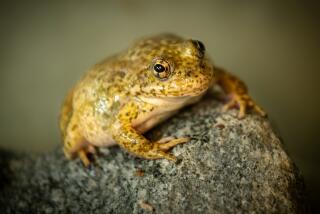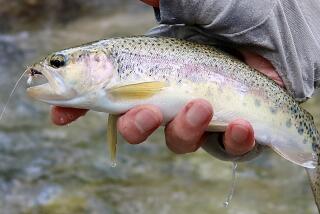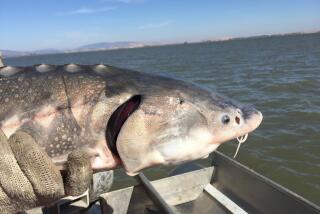Predatory and voracious, the ‘little eating machines’ thrive in Santa Clara River despite a 15-year eradication campaign. : African Frogs Remain Kings of the Canyon
- Share via
In muddy ponds and gurgling creeks above the Santa Clarita Valley, a small army of biologists is waging war against a fat, slimy and voracious enemy--the African clawed frog.
So far, the frogs are winning.
“We haven’t come up with a solution,” said Jim A. St. Amant, a state Department of Fish and Game biologist, who has tried to eradicate the pesky frogs for 15 years. “I’m not optimistic.”
The camouflage-green frogs are decimating the last known population of the unarmoured threespine stickleback, a tiny endangered fish found only where the Santa Clara River flows through Soledad Canyon.
The canyon frog colony is the largest known infestation of African clawed frogs in Southern California, biologists and state and local water officials say. St. Amant said the frogs presumably are the descendants of laboratory escapees or failed aquarium pets released by disgusted owners. Their only natural enemies in California are biologists.
Migration Feared
St. Amant said biologists hope not only to save the three-inch stickleback, but to prevent the frog from migrating south into reservoirs and flood-control channels, where they could reproduce wildly. “They certainly are prolific as the devil,” St. Amant said.
In an incident reminiscent of a science-fiction movie, the Metropolitan Water District of Southern California destroyed a million of the frogs that clogged the large San Joaquin Reservoir above Newport Beach in 1985. District officials committed amphibicide by draining the concrete-lined reservoir--100 feet deep in places--and scooping out the frogs with nets.
Jim Dole, a biology professor from Cal State Northridge, is helping direct the latest assault on the frogs, which were brought to the United States from southern Africa in the 1940s as laboratory animals. Dole and graduate students have trapped and killed thousands of clawed frogs over the past three years, trying to assess their numbers and habits in Soledad Canyon. He said they hope to compile their findings at the end of the summer.
“We’re trying to trap as many and kill as many as possible,” said Cydney Henderson, a CSUN graduate student in environmental biology.
Stickleback defenders hope Dole’s research will provide clues on how to stamp out the resilient amphibian. So far, the research only shows that thousands of frogs are gobbling up sticklebacks in the Soledad Canyon ponds. “I really don’t have any answers,” Dole said.
‘Eating Machines’
The African clawed frog, or Xenopus laevis, can grow to about eight inches with legs extended. They use three tiny black claws on each of their hind legs to shred their prey. “They’re just little eating machines,” said Harvey Fischer, curator of reptiles and amphibians at the Los Angeles Zoo.
It is illegal to sell or own the black-eyed frogs, but they were once sold in pet stores, Fischer said. Many disillusioned aquarium owners freed the frogs after the hungry amphibians cleaned their tanks of fish, he said. The African frogs also devour insects, crustaceans and other frogs--even other African clawed frogs.
St. Amant discovered the frogs’ cannibalistic tendencies when he first encountered them in 1974. He plopped tadpoles, adolescents and adults into a bucket and drove off to his lab. “I got back and all we had were adults.”
While African clawed frogs will eat anything, it appears nothing will eat African clawed frogs.
The adults are “predator-proof,” secreting a poisonous, foul-tasting mucus that repels larger fish and animals. Large-mouthed bass have spit them out. Researchers say a red fox ate one and had a heart attack. St. Amant said he fed one to a snapping turtle and it wouldn’t eat for days.
Tadpoles Vulnerable
The frogs are only vulnerable while tadpoles, which explains why their populations are kept in check in large bodies of water where there are lots of predatory fish, said Robin Garcia of the Museum of Natural History in San Diego.
For example, catfish were released into the San Joaquin Reservoir to finish off the few survivors of the Orange County frog massacre. But predatory fish cannot be released in the Soledad Canyon ponds because they would also devour the stickleback, researchers say.
“It’s very difficult to do something that isn’t going to affect the fish at the same time,” Henderson said. Poison, for example, doesn’t work. “The frogs jump out and it kills the fish,” she said.
In Soledad Canyon, biologists even zapped the frogs with carefully aimed electrical currents, said Ken Sasaki, a state fishery biologist who heads the stickleback recovery team. But the method didn’t work in deep ponds. The biologists only electrocuted frogs “dumb enough to get into range,” he said.
Biologists tried draining one pond to vanquish the frogs, but a year later they were back.
Sasaki, St. Amant and about a dozen frog-killers launched an unprecedented three-day assault on the Africans last August, catching hundreds in 30 wire-mesh traps baited with diced beef liver and chicken backs. A second large-scale trapping effort was repeated in January.
Traps Inefficient
“We finally came to the conclusion that that’s not going to work,” St. Amant said. Each female frog releases thousands of eggs and the traps, while killing adults, could not stop the next generation, he said. But Sasaki said the traps might be able to at least keep populations of the frog in check.
Collecting good data on the frogs is difficult because they spend almost all their lives hidden underwater, poking their snouts above the surface occasionally to breath. Henderson said the frogs have the amazing ability to absorb oxygen from the water through their skin. They can stay in submerged traps for hours and not drown.
“A pond could be full of them, and you’ll never know it,” Sasaki said.
That was the case on a recent Sunday when Henderson and her son, Jason, 11, and her boyfriend, Jose Antonio Montes, drove to Soledad Canyon to collect 27 traps she had set in a pond the night before. The still pond, bordered by only a few trees, looked lifeless.
“What could possibly live here?” Henderson asked.
But Jason and Montes were soon hauling in traps filled with frogs. They dumped their catch into a bucket of water and ethyl alcohol where the frogs quickly expired.
65 Caught
The death toll was 65 frogs--not a great catch, Henderson said. The last time out, they caught about 160.
Back at the CSUN biology department, Henderson injected the dead frogs with alcohol to preserve their innards. She later measures the frogs and saves the larger ones for dissection.
Research is limited to post-mortem examinations because the frogs’ great fertility prevents biologists from tagging and releasing them back into the eight ponds under study, Dole said. Dole said he is allowed by the Fish and Game Department to bring back live frogs only in a double-locked container to prevent escapes.
In the future, perhaps a poison can be developed to kill only the frogs, Sasaki said. Dole guessed that sterile males could be released to break the breeding cycle--a method used on Mediterranean fruit flies.
But perhaps, Dole conceded, the research will offer no answers. “It may be a waste of time,” he said.
More to Read
Sign up for Essential California
The most important California stories and recommendations in your inbox every morning.
You may occasionally receive promotional content from the Los Angeles Times.










